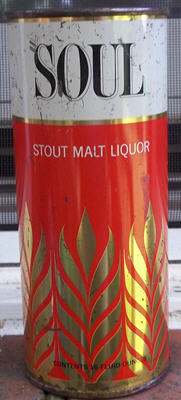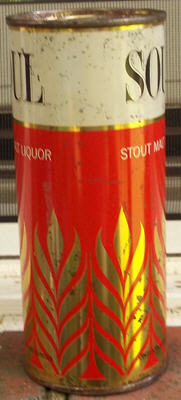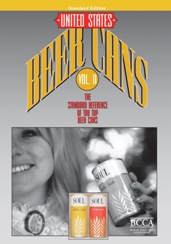Soul Stout Malt Liquor: 1967
 |
 |
This is a rather famous beer can. It's not rare, you will see at least one at every good-sized can show. You can pick up a slightly off-grade one like this for about $100 or so. Back when can collecting was gaining in popularity in the 1970s, however, there were all sorts of urban legends about it that drove its value far higher than was deserved. The story was that it was produced in 1965 and the brewery was destroyed in the Watts Riot. Totally False. The story is still out there though, and repeated by lazy researchers. The can was made in 1967 and it was part of the history of the Civil Rights Movement in the 1960s. Let's look at Soul Malt Liquor and how it fits into the context of its time.
Breweries and African-Americans
Breweries don't like to miss any possible customer but, during the Jim Crow period (roughly 1890-1965) especially, being known as a product favored by one particular group, whether it be racial, ethnic, religious, etc, could easily lose a product customers among other groups. A longtime Baltimore resident once told me that the city's breweries would sometimes try to spread the story that a rival brand was "n****r beer" in order to alienate white customers. Breweries rarely marketed to minorities so as to not lose customers among a larger group. African-Americans appeared in some brewery advertising, usually as servants or waiters. I already discussed this aspect a bit with my May 2004 COM, the Atlantic "Plantation Can." I also discussed the possibly racial issues that were involved in New York's popular Miss Rheingold contest in my July 2007 COM.
A few breweries went against the grain and used marketing campaigns specifically aimed at the black population in their sales area. Pennsylvania'sAdam Scheidt Brewing distributed point-of-sale advertising pieces featuring African-Americans in roles besides servants, waiters or clownish figures. It's probably no accident that Scheidt's brands (Valley Forge and Rams Head Ale) were the biggest sellers in Washington, DC with its large black population. Baltimore's Gunther Brewing also tried to establish a positive working relationship with black consumers in DC.
By the mid 1960s, many brewers found that trying to discretely ignore such a large customer base was no longer possible. African-Americans began appearing in beer ads along with white consumers (and presumably Hispanics in the Southwest). Moreover, brewers found that Malt Liquors were especially popular among black customers, and they became a popular niche. To quote from a great website with a history of malt liquor. (LINK)
...while black Americans comprise 12-14% of the population, they consume 30-33% of the malt liquor brewed in the U.S. The statistic is important for two reasons. First, it shows why brewers of malt liquor advertise more heavily to black people: As a group, they buy more malt liquor. The second important fact is that if a third of all malt liquor is consumed by black Americans, two thirds are consumed by people who are not black.
Maier Brewing in Los Angeles tried to jump on the same marketing bandwagon. They introduced two new beers in 1967, Soul Stout Malt Liquor and Soul Mellow Yellow Beer. The name "Soul" may have been too blatant an appeal to black customers as both brands met with protests and they flopped. The beer may not have been that good either, as the brewery was on its last legs. In either event, Soul did not last long. It may have been the first attempt to develop a brand specifically aimed at African-American customers, and not just to try to design some advertisements to capture part of the black customer base for an established brand.
After Soul there would be a few other attempts. Black Pride and People's Beer were two examples from the 1970s, both out of Wisconsin. They also failed. Since then, brewers have developed brands specifically for the so-called "urban" market, and designed their advertising accordingly, but brands such as Midnight Dragon were not overtly aimed at customers on a specific race as openly as was Soul.
The Soul Cans
There are four Soul cans, a 12 oz and a 16 oz for each brand. The yellow "Mellow Yellow Beer" cans are harder to find than the red Malt Liquor cans. The can featured here is the most common of the four. It remains a popular brand for collectors, enough so that it was the featured can on the BCCA's tab-top can book in 2007.
 |
Urban Legends
There are a few variations of the Soul urban legend, but they all involve the Watts Riot of 1965. According to the tale, the brand was only sold in Watts during the riot, or was introduced in 1965 but the riots burned down the brewery. No doubt there are other variations. A quick Google (or Bing) search would quickly disprove them, but lazy researchers keep repeating them. The brewery was nowhere near Watts, and the idea that a brewer would come out with a brand just for a riot is plain silly.
The BCCA has tried to set the record straight ever since the mid 1970s. The BCCA book The Beer Can noted that the stories were untrue, as did Lew Cady's popular book on can collecting. Cady even noted that many colelctor didn't consider the can that difficult to get. However, they noted that the stories, and eye appeal, made the can more desirable than other, truly rare, cans.
